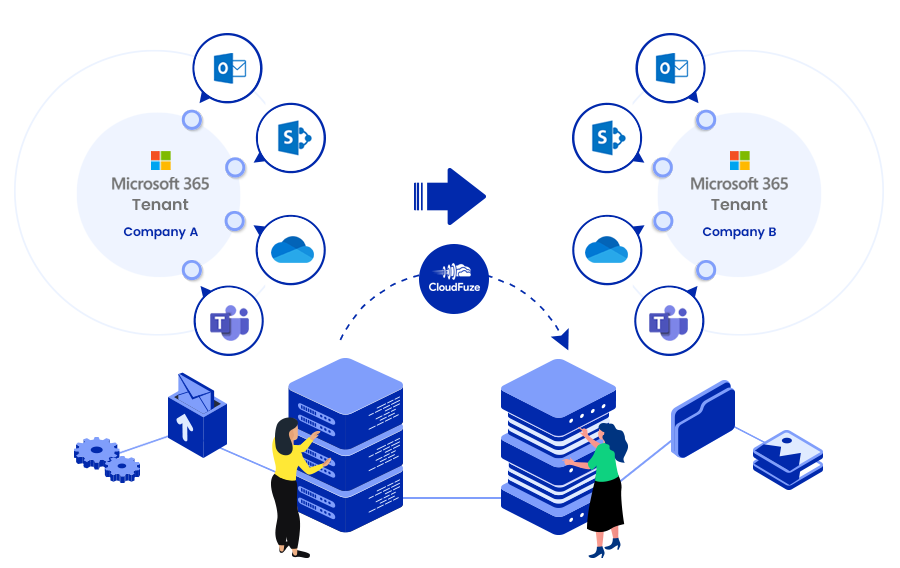Steps to do Office 365 Tenant To Tenant Migration
Office 365 Tenant-to-Tenant migration involves transferring data, services, and configurations from one Office 365 tenant to another. This process is essential during mergers, acquisitions, divestitures, or rebranding. Ensuring a seamless migration is crucial to minimize downtime and maintain productivity. This comprehensive guide covers the steps to execute an efficient Office 365 Tenant-to-Tenant migration.
Planning the Migration
- Assess Current Environment:
- Inventory: Identify and document all Office 365 components in both the source and target tenants, including mailboxes, SharePoint sites, OneDrive accounts, Teams, and any custom applications or configurations.
- Usage Patterns: Analyze usage patterns to understand peak times and avoid migrating during high-usage periods to minimize disruptions.
- Define Scope and Objectives:
- Scope: Determine the extent of the migration. Decide whether to migrate everything or only specific components.
- Objectives: Establish clear goals, such as minimizing downtime, ensuring data integrity, and maintaining user productivity.
- Develop a Migration Plan:
- Timeline: Create a detailed timeline with key milestones, considering business hours, weekends, and holidays.
- Communication Plan: Develop a communication strategy to inform stakeholders and end-users about the migration process, including timelines, expected downtime, and support resources.
Preparing for Migration
- Tenant Preparation:
- Licensing: Ensure the target tenant has sufficient licenses to accommodate the migrating users and services.
- Domain Setup: Verify that the target tenant’s domain is correctly set up. If necessary, add and verify the source tenant’s domain in the target tenant.
- User Preparation:
- User Mapping: Map users from the source tenant to the target tenant. This includes aligning user accounts, mailboxes, OneDrive accounts, and other services.
- Permissions and Roles: Review and replicate permissions and roles in the target tenant to maintain access levels and security settings.
- Data Preparation:
- Data Backup: Perform a comprehensive backup of all data in the source tenant to prevent data loss.
- Clean-Up: Remove or archive outdated or unnecessary data to streamline the migration process.
Executing the Migration
- Mail Migration:
- Pre-Stage Mailboxes: Use tools like Microsoft’s Exchange Admin Center (EAC) or third-party solutions to pre-stage mailboxes. This involves copying mailbox data to the target tenant in advance to reduce the final cutover time.
- Cutover: Schedule the final cutover during a low-usage period. During cutover, switch MX records to direct email flow to the target tenant. Perform a final synchronization to ensure all recent emails are migrated.
- OneDrive and SharePoint Migration:
- Pre-Migration Assessment: Analyze OneDrive and SharePoint data for large files, custom scripts, or unsupported features that might require special handling.
- Migration Tools: Utilize tools like SharePoint Migration Tool (SPMT) or third-party solutions to transfer OneDrive and SharePoint data. Ensure metadata and permissions are preserved during the migration.
- Teams Migration:
- Teams Inventory: Document the Teams structure, including channels, tabs, and settings.
- Migration Execution: Use tools like Microsoft Teams Migration Tool or third-party solutions to migrate Teams. Ensure chat history, files, and configurations are transferred correctly.
Post-Migration Activities
- Validation and Testing:
- Data Integrity: Verify that all data has been successfully migrated. Check for missing or corrupted data and rectify any issues.
- Functionality Testing: Test key functionalities in the target tenant, including email flow, file access, and application integrations.
- User Verification:
- User Access: Confirm that users can access their accounts and services in the target tenant without issues.
- Support: Provide support resources, such as helpdesk contacts and troubleshooting guides, to assist users with any post-migration issues.
- Decommission Source Tenant:
- Final Backup: Perform a final backup of the source tenant before decommissioning.
- Deactivation: Deactivate the source tenant once all data and services have been verified in the target tenant.
Also read – 20 best Microsoft Alternatives
Tools and Best Practices
- Migration Tools:
- Microsoft Native Tools: Utilize Microsoft’s native tools like Exchange Admin Center, SharePoint Migration Tool, and Teams Migration Tool for seamless migration.
- Third-Party Solutions: Consider third-party solutions like BitTitan MigrationWiz, Quest OnDemand Migration, or ShareGate for advanced features and capabilities.
- Best Practices:
- Pilot Testing: Conduct pilot migrations with a small group of users to identify and resolve potential issues before full-scale migration.
- Communication: Maintain clear and consistent communication with all stakeholders throughout the migration process.
- Documentation: Keep detailed documentation of the migration plan, processes, and any issues encountered for future reference and compliance.
Conclusion
Office 365 Tenant-to-Tenant migration is a complex but manageable process with careful planning and execution. By following the steps outlined in this guide, organizations can ensure a smooth transition, maintain productivity, and minimize disruptions. Proper preparation, leveraging the right tools, and adhering to best practices are key to a successful Office 365 Tenant-to-Tenant migration.






